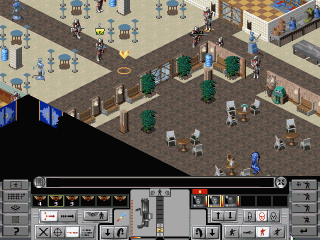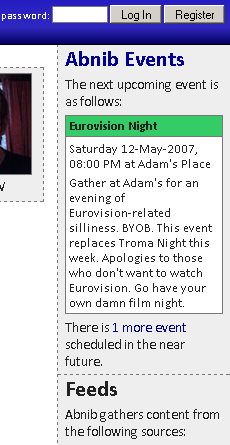It may come as a surprise to you that the stuff I write about on my blog – whether about technology, dreams, food, film, games, relationships, or my life in general – isn’t actually always written off-the-cuff. To the contrary, sometimes a post is edited and re-edited over the course of weeks or months before it finally makes it onto the web. When I wrote late last year about some of my controversial ideas about the ethics (or lack thereof) associated with telling children about Santa Claus, I’m sure that it looked like it had been inspired by the run-up to Christmas. In actual fact, I’d begun writing it six months earlier, as summer began, and had routinely visited and revisited it from time to time until I was happy with it, which luckily coincided with the Christmas season.
As an inevitable result of this process, it’s sometimes the case that a blog post is written or partially-written and then waits forever to be finished. These forever-unready, never-published articles are destined to sit forever in my drafts folder, gathering virtual dust. These aren’t the posts which were completed but left unpublished – the ones where it’s only upon finishing writing that it became self-evident that this was not for general consumption – no, the posts I’m talking about are those which honestly had a chance but just didn’t quite make it to completion.
Well, today is their day! I’ve decided to call an amnesty on my incomplete blog posts, at long last giving them a chance to see the light of day. If you’ve heard mention of declaring inbox bankruptcy, this is a similar concept: I’m sick of seeing some of these blog articles which will never be ready cluttering up my drafts folder: it’s time to make some space! Let the spring cleaning begin:
Title: Typically Busy
Unpublished since: March 2004
Unpublished because: Better-expressed by another post, abandoned
In this post, I talk about how busy my life is feeling, and how this is pretty much par for the course. It’s understandable that I was feeling so pressured: at the time we were having one of our particularly frenetic periods at SmartData, I was fighting to finish my dissertation, and I was trying to find time to train for my upcoming cycle tour of Malawi. The ideas I was trying to express later appeared in a post entitled I’m Still In Aber. Yay, in a much more-optimistic form.
Title: Idloes, Where Art Thou?
Unpublished since: June 2004
Unpublished because: Got distracted by rebuilding the web server on which my blog is hosted, after a technical fault
In anticipation of my trip to Malawi, I was prescribed an anti-malarial drug, Lariam, which – in accordance with the directions – I began taking daily doses of several weeks before travelling.
It seemed silly in the long run; I never even saw a single mosquito while I was over there, but better safe than sorry I suppose. In any case, common side-effects of Lariam include
delusions, paranoia, strange dreams, hallucinations, and other psychological
effects. I had them in spades, and especially the weird trippy dreams.

This blog post described what could have been one of those dreams… or, I suppose, could have just been the regular variety of somewhat-strange dream that isn’t uncommon for me. In the dream I was living back in Idloes, a tall Aberystwyth townhouse where I’d rented a room during 2002/2003. In the dream, the house caught fire one night, and my landlady, Anne, was killed. Apparently the fire was started by her electric blanket.
Title: Are We Alone In The Universe?
Unpublished since: March 2006
Unpublished because: Never finished, beaten to the punchline
Here’s an example of an article that I went back to, refining and improving time and time again over a period of years, but still never finished. I was quite pleased with the direction it was going, but I just wasn’t able to give it as much time as it needed to reach completion.
In the article, I examine the infamous Drake Equation, which estimates the likelihood of there being intelligent life elsewhere in the galaxy (more specifically, it attempts to estimate the number of intelligent civilizations “out there”). Which is all well and good, but the only way to put the formula into practice is to effectively pull unknowable numbers out of the air and stuff them into the equation to get, in the end, whatever answer you like. The only objective factors in the entire equation are those relating to the number of stars in the galaxy, and everything else is pure conjecture: who honestly thinks that they can estimate the probability of any given species reaching sentience?
The post never got finished, and I’ve since seen other articles, journals, and even stand-up comedians take apart the Drake Equation in a similar way to that which I intended, so I guess I’ve missed the boat, now. If you want to see the kind of thing I was working on, here it is but better-written. I wonder what the probability is that a blog post will never end up being published to the world?
Title: Why Old People Should Be Grumpy
Unpublished since: October 2006
Unpublished because: Never finished, possibly bullshit
In this post, I put forward a theory that grumpy old people are a positive sign that a nation is making just enough change to not be stagnant: something about the value of keeping older people around crossed with the importance of taking what they say with a pinch of salt, because it’s not them that has to live in the world of tomorrow. I can’t even remember what the point was that I was trying to make, and my notes are scanty, but I’m sure it was a little bit of a one-sided argument for social change with an underdeveloped counter-argument for social stability.
In any case, I left it for years and eventually gave up on it.
Title: The Games That Didn’t Make The List
Unpublished since: July 2007
Unpublished because: I could have kept refining it forever and still never finish it
After my immensely popular list of 10 Computer Games That Stole My Life, I received a great deal of feedback – either as direct feedback in the form of comments or indirectly in other people’s blogs. Reading through this feedback got me thinking about computer games that had stolen my life which I hadn’t mentioned. Not wanting to leave them out, I put together a list of “games that didn’t make the list”: i.e. games which could also have been said to steal my life, but which I didn’t think of when I wrote my original top ten. They included:

-
Castles and Castles 2
The original Castles was one of the first non-free PC computer games I ever owned (after Alley Cat, that golf game, and the space command/exploration game whose name I’ve been perpetually unable to recall). It was a lot of fun; a well-designed game of strategy and conquest. Later, I got a copy of Castles 2 – an early CD-ROM title, back before developers knew quite what to do with all that space – which was even better: the same castle-building awesomeness but with great new diplomacy and resource-management exercises, as well as siege engines and the ability to launch your own offensives. In the end, getting Civilization later in the same year meant that it stole more of my time, but I still sometimes dig out Castles 2 and have a quick game, from time to time. -
Yohoho! Puzzle Pirates!
Early during the development of Three Rings, I came across an existing company with the name Three Rings Design, based in the US. Their major product is a game called Yohoho! Puzzle Pirates, an MMOG in which players – as pirates – play puzzle games in order to compete at various tasks (you know, piratey tasks: like sailing, drinking, and swordfighting). Claire and I both got quite deeply involved during the beta, and played extensively, even forming our own crew, The Dastardly Dragons, at one point, and met some fascinating folks from around the world. When the beta came to an end we both took advantage of a “tester’s bonus” chance to buy lifetime subscriptions, which we both barely used. Despite the fact that I’ve almost never played the game since then, it still “stole my life” in a quite remarkable way for some time, and my experience with this (as well as with the Ultima Online beta, which I participated in many years earlier) has shown me that I should never get too deeply involved with MMORPGs again, lest they take over my life. -
Sid Meier’s Alpha Centauri
As a Civilization fan, I leapt on the chance to get myself a copy of Alpha Centauri, and it was awesome. I actually pirated my first copy of the game, copying it from a friend who I studied with, and loved it so much that I wrapped up the cash value of the game in an envelope and sent it directly to the development team, asking them to use it as a “beer fund” and have a round on me. Later, when I lost my pirated copy, I bought a legitimate copy, and, later still, when I damaged the disk, bought another copy, including the (spectacular) add-on pack. Alpha Centauri is the only game I’ve ever loved so much that I’ve paid for it three times over, despite having stolen it, and it was worth every penny. Despite its age, I still sometimes dig it out and have a game. -
Wii Sports Tennis – Target Training
Perhaps the most recent game in the list, this particular part of the Wii Sports package stole my life for weeks on end while I worked up to achieving a coveted platinum medal at it, over the course of several weeks. I still play it once in a while: it’s good to put on some dance music and leap around the living room swinging a Wiimote to the beat. -
Rollercoaster Tycoon and Rollercoaster Tycoon 2
In the comments to my original post, Rory reminded me of these games which stole my life during my first couple of years at University (and his, too!). RCT2, in particular, ate my time for years and still gets an occassional play out of me – but was pipped to the post by OpenTTD, of course. -
X-COM series
Another series of games which hooked me while I was young and stayed with me as I grew, the X-COM series (by which – of course – I mean Enemy Unknown, Terror From The Deep, and Apocolypse; not Interceptor and certainly not that modern travesty, Aftermath). Extremely difficult, each of them took me months or years before I completed them, and I’ve still never finished Apocalypse on anything higher that the lowest-two difficulty settings.

I wanted to write more and include more games, but by the time I’d made as much progress as I had, above, the moment felt like it had passed, so I quietly dropped the post. I suppose I’ve now shared what I was thinking, anyway.
Title: Rational Human Interaction
Unpublished since: September 2007
Unpublished because: Too pretentious, even for me; never completed
I had some ideas about how humans behave and how their rationality and their emotions can conflict, and what this can mean. And then I tried to write it down and I couldn’t find a happy medium between being profound and insightful and being obvious and condescending. Later, I realised that I was tending towards the latter and, besides, much of what I was writing was too self-evident to justify a blog post, so I dropped it.
Title: Long Weekend
Unpublished since: April 2008
Unpublished because: Too long, too wordy, and by the time it was nearing completion it was completely out of date
This post was supposed to be just an update about what was going on in my life and in and around Aber at the time. But as anybody who’s neglected their blog for more than a little while before may know, it can be far too easy to write about everything that’s happened in the interim, and as a result end up writing a blog post that’s so long that it’ll never be finished. Or maybe that’s just me.
In any case, the highlights of the post – which is all that it should have consisted of, ultimately – were as follows:
- It was the Easter weekend on 2008, and town had gone (predictably) quiet, as many of my friends took the opportunity to visit family elsewhere, and there was a particular absence of tourists this year. Between Matt being in Cornwall, Sarah being out-of-town, and Ruth, JTA, Gareth and Penny off skiing (none of them wrote anything about it, so no post links there), it felt a little empty at our Easter Troma Night, which was rebranded a Troma Ultralite as it had only two of the requisite four people present: not even the three needed for a Troma Lite! Similarly, our Geek Night only had four attendees (but that did include Paul, unusually).
- Claire and I took a dig through her wardrobe about found that of the skirts and dresses that she famously never wears, she owns over two dozen of them. Seriously.
- I played and reviewed Turning Point: Fall Of Liberty, which turned out to be a second-rate first-person shooter with a reasonably clever alternate history slant. I’m a fan of alternate histories in video games, so this did a good job of keeping me amused over the long bank holiday weekend.
- Paul and I were arranging for a beach-fire-barbeque with Ruth and JTA when they got back, to which we even anticipated attendence from the often-absent not-gay-Gareth.
- And finally, I had something to say about Jimmy‘s recent experiences in Thailand, but that’s as far as my draft went and I don’t remember what I had planned to say…
Title: Confused And Disoriented
Unpublished since: April 2008
Unpublished because: Never finished; abandoned
Having received mixed feedback about my more-unusual dreams over the years, I’ve taken to blogging about a great number of them in order to spread the insanity and let others comment on quite how strange my subconscious really is. This was to be one of those posts, and it catalogued two such unusual dreams.
In the first, I was at my grandma’s funeral (my grandma had died about two years earlier). A eulogy was given by both my mum and – confusingly – by Andy R. Afterwards, the crowd present booed them.
In the second, I revisited a place that I’ve dreamed of many times before, and which I think is a reference to some place that I found as a young child, but have never been able to determine the location of since. In this recurring theme I crawl through a tunnel (possibly of rock, as in a ruined castle) to reach a plateau (again, ruined castle-like), from which I am able to shuffle around to a hidden ledge. I have such vivid and strong memories of this place, but my faith in my own memory is shaken by the very “dreamlike” aspects of the event: the tunnel, the “secret place”, as well as the fact that it has appeared in my dreams time and time again for over 15 years. Perhaps it never existed at all: memory is a fragile and malleable thing, and it’s possible that I made it up entirely.
Some parts of it are less dream-like. For example, I’m aware that I’ve visited this place a number of times at different ages, and that I found it harder to fit through the tunnel to re-visit my secret childhood hiding place when I was older and larger.
A few years ago, I spoke to my mum about this dream, and described the location in great detail and asked where it might be, and she couldn’t think of anywhere. It’s strange to have such a strong and profound memory that I can’t justify through the experience of anybody else, and which consistently acts as if it were always just a dream. Maybe it’s real, and maybe it isn’t… but it’s beginning to sound like I’ll never know for sure.
Title: The Code In The School
Unpublished since:May 2008
Unpublished because: Never finished; abandoned
Another dream, right after Troma Night 219, where it seems that the combination of the beer and the trippy nature of the films we watched inspired my brain to run off on a tangent of it’s own:
In the dream, I was visiting a school as an industrialist (similarly to how I had previously visited Gregynog on behalf of the Computer Science department at Aberystwyth University in 2005, 2006 and 2007). While there, I was given a challenge by one of the other industrialists to decipher a code represented by a number of coloured squares. A basic frequency analysis proved of no value because the data set was too small, but I was given a hint that the squares might represent words (sort of like early maritime signal flags). During mock interviews with the students, I used the challenge as a test, to see if I could get one of them to do it for me, without success. Later in the dream I cracked the message, but I’m afraid I didn’t make a record of how I did so or what the result was.
Title: Absence
Unpublished since: May 2008
Unpublished because: Forgotten about; abandoned
At the beginning of the long, hot summer of 2008, I wrote about the immenent exodus of former students (and other hangers-on) from Aberystwyth, paying particular attention to Matt P and to Ele, who left for good at about this time. And then I forgot that I was writing about it. But Matt wrote about leaving and Ele wrote about being away, anyway, so I guess my post rapidly became redundant, anyway.
Title: =o(
Unpublished since: June 2008
Unpublished because: Too negative; unfinished
I don’t even know what I was complaining about, but essentially this post was making an excuse to mope for a little while before I pull myself together and get things fixed. And that’s all that remains. It’s possible that it had something to do with this blog post, but without context I’ve no idea what that one was about, too. Sounds like it was about an argument, and so I’m happier just letting it go, whatever it was, anyway.
Title: Spicy Yellow Split Pea Soup
Unpublished since: November 2008
Unpublished because: Got lazy; unfinished
I came up with a recipe for a delicious spicy yellow split pea soup, and wanted to share it with you, so I made myself the stub of a blog entry to remind myself to do so. And then I didn’t do so. Now I don’t even remember the recipe. Whoops!
In any case, the moral is that pulses make great soup, as well as being cheap and really good for you, and are especially tasty as the days get shorter and winter tightens it’s icy grip. Also that you shouldn’t leave just a title for a blog post for yourself and expect to fill it in afterwards, because you won’t.
Title: (untitled)
Unpublished since: December 2008
Unpublished because: Too busy building, configuring, and working on my new PC, ironically
December is, according to Rory, the season for hardware failures, and given that alongside his troubles, Ruth’s laptop died and Paul’s computer started overheating, all at the same time, perhaps he’s right. So that’s when my long-serving desktop computer, Dualitoo, decided to kick the bucket as well. This was a particularly awkward time, as I was due to spend a weekend working my arse off towards a Three Rings deadline. Thankfully, with the help of friends and family, I was able to pull forward my plans to upgrade anyway and build myself a new box, Nena (which I continue to use to this day).
I began to write a blog post about my experience of building a computer using only local shops (I was too busy to be able to spare the time to do mail order, as I usually would), but I was unfortunately too busy building and then using – in an attempt, ultimately successful, to meet my deadline – my new computer to be able to spare time to blogging.
But I did learn some valuable things about buying components and building a mid-to-high spec computer, in Aberystwyth, all in one afternoon:
-
Daton Computers are pretty much useless. Actual exchange:
“Hi, I need to buy [name of component], or another [type of component] with [specification of component].”
“Well, you’ll need to bring your computer in for us to have a look at.”
“Umm; no – I’m building a computer right now: I have [other components], but I really need a [name of component] or something compatible – can you help?”
“Well, not without looking at the PC first.”
“WTF??? Why do you need to look at my PC before you can sell me a [type of component]?”
“So we can tell what’s wrong.”
“But I know what’s wrong! I only took the shrink-wrap off the [other components] this morning: all I need is a [type of component], because I don’t have one! Now can you sell one to me or not?”
“Well, not without -”
/Dan exits/ -
Crosswood Computers are pretty much awesome. Actual exchange:
“Hi, remember me? I was in here this morning.”
“Yeah: how’s the rebuild going?”
“Not bad, but I’ve realised that I’m short by a [type of cable]: do you sell them?”
“We’re out of stock right now, but I’ve got some left-over ones in the back; you can have one for free.”
/Dan wins/ - It’s possible to do this, but not recommended. The local stores, and in particular Crosswood, are great, but when time allows it’s still preferable to do your component-shopping online.
I later went on to write more about Nena, when I had the time.
Title: Child Porn
Unpublished since: April 2009
Unpublished because: Never finished; too much work in writing this article
I had planned to write an article about the history of child pornography, starting well before Operation Ore and leading up to the present day, and to talk about the vilification of paedophiles (they’re the new terrorists!) – to the point where evidence is no longer as important as the severity of the alleged crime (for particularly awful examples of this kind of thinking, I recommend this article). I’m all in favour of the criminalisation of child abuse, of course, but I think it’s important that people understand the difference between the producers and the consumers of child porn, as far as a demonstrable intent to cause harm is concerned.
Anyway, the more I read around the subject, the more I realised that nothing I could write would do justice to the topic, and that others were already saying better what I was thinking, so I abandoned the post.
Title: 50 Days On An EeePC 1000
Unpublished since: May 2009
Unpublished because: By the time I was making progress, it had been more like 150 days
Earlier in the year, I’d promised that I’d write a review of my new notebook, an Asus EeePC 1000. I thought that a fun and engaging way to do that would be to write about the experience of my first 50 days using it (starting, of course, with reformatting it and installing a better operating system than the one provided with it).
 Of course, by the time I’d made any real progress on the article, it
was already well-past 50 days (in fact, I’d already changed the title of the post twice, from “30 Days…” to “40 Days…” and then again to “50 Days…”). It’s still a great laptop, although
I’ve used it less than I expected over the last nine months or so (part of my original thinking was to allow me to allow Claire to feel like she’d reclaimed the living room, which was
being taken over by Three Rings) and in some ways it’s been very-recently superceded by my awesome
mobile phone.
Of course, by the time I’d made any real progress on the article, it
was already well-past 50 days (in fact, I’d already changed the title of the post twice, from “30 Days…” to “40 Days…” and then again to “50 Days…”). It’s still a great laptop, although
I’ve used it less than I expected over the last nine months or so (part of my original thinking was to allow me to allow Claire to feel like she’d reclaimed the living room, which was
being taken over by Three Rings) and in some ways it’s been very-recently superceded by my awesome
mobile phone.
Title: El De-arr
Unpublished since: September 2009
Unpublished because: Too waffley; couldn’t be bothered to finish it; somewhat thrown by breaking up with Claire
Over the years I’ve tried a handful of long-distance romantic relationships, and a reasonable number of short-distance ones, and, in general, I’ve been awful at the former and far better at the latter. In this blog post I wrote about my experience so far of having a long-distance relationship with Ruth and what was making it work (and what was challenging).
I’m not sure where I was going with it in the first place, but by the time Claire and I broke up I didn’t have the heart to go back into it and correct all of the references to her and I, so I dropped it.
Title: Knowing What I’m Talking About
Unpublished since: October 2009
Unpublished because: Never finished; got distracted by breaking up with Claire
On the tenth anniversary since I started doing volunteer work for emotional support helplines (starting with a Nightline, and most recently for Samaritans), I wrote about a talk I gave at BiCon 2009 on the subject of “Listening Skills for Supporting Others”. It was a little under-attended but it went well, and there was some great feedback at the end of it. I’d helped out with a workshop entitled “Different Approaches to Polyamory” alongside fire_kitten, but strangely it was this, the workshop whose topic should be that which I have the greater amount of experience in, that made me nervous.
This blog post was supposed to be an exploration of my personal development over the previous decade and an examination of what was different about giving this talk to giving countless presentations at helpline training sessions for years that made me apprehensive. I think it could have been pretty good, actually. Unfortunately a lot of blog posts started around this time never ended up finished as I had other concerns on my plate, but I might come back to this topic if I give a similar presentation at a future conference.
So there we have it: a big cleanse on my perpetually unfinished blog posts. I’ve still got about eight drafts open, so there’s a reasonable chance that I might finish some of them, some day: but failing that, I’ll wait until another decade or so of blogging is up and I’ll “purge” them all again, then.
And if you had the patience to read all of these – these “17 blog posts in one” – well, thanks! This was more about me than about you, so I don’t mind that plenty of you will have just scrolled down to the bottom and read this one sentence, too.








 “All of the days of the week are in French!”
“All of the days of the week are in French!”






 I suppose I brought it
upon myself. I’ve always been a fan of machines. When I was very young, kids TV programme
I suppose I brought it
upon myself. I’ve always been a fan of machines. When I was very young, kids TV programme 
 Nowadays, if you want to play a
huge, open, expansive, deep roleplaying game, you install
Nowadays, if you want to play a
huge, open, expansive, deep roleplaying game, you install  This list really couldn’t be complete without tipping
my hat to
This list really couldn’t be complete without tipping
my hat to  Now here was a game that you could get into.
Now here was a game that you could get into.  I’d played
I’d played  Most of the games in this list stole my life simply because I kept coming back to them time and time again, even years after I’d finished them or thought I’d seen everything
there was to see in them. A couple of the games in this list stole my life because it took me so long to explore them fully – to do everything there was to do in them, to complete
them on the hardest difficulty level, etc.
Most of the games in this list stole my life simply because I kept coming back to them time and time again, even years after I’d finished them or thought I’d seen everything
there was to see in them. A couple of the games in this list stole my life because it took me so long to explore them fully – to do everything there was to do in them, to complete
them on the hardest difficulty level, etc.
 I bought
I bought  And so we come
to the number one life-stealing game for me, perhaps forever:
And so we come
to the number one life-stealing game for me, perhaps forever:  In order to reduce the
amount of time my blog spends being used to organise events like Black Red Dwarf Adder Nights and whatnot, I’ve launched
In order to reduce the
amount of time my blog spends being used to organise events like Black Red Dwarf Adder Nights and whatnot, I’ve launched 